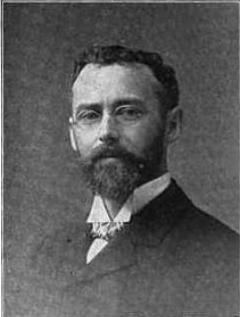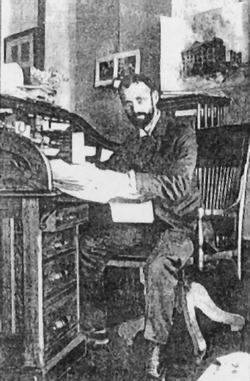Name C. J. Role Architect | ||
 | ||
Structures P.S. 157, PS 17, Public School 9 | ||
C. B. J. Snyder
Charles B. J. Snyder (November 4, 1860 – November 14, 1945) was an American architect, architectural engineer, and mechanical engineer in the field of urban school building design and construction. He is widely recognized for his leadership, innovation, and transformation of school building construction process, design, and quality during his tenure as Superintendent of School Buildings for the New York City Board of Education between 1891 and 1923.
Contents
- C B J Snyder
- Background
- Superintendent of School Buildings
- School design innovations
- Retirement
- Notable architecture
- Elementary schools
- High schools
- Structural additions
- Demolished structures
- Professional affiliations
- Family and personal life
- Publications and presentations
- References

Background
Snyder was born November 4, 1860, in Stillwater, New York. He was the middle of three children born to George I. Snyder (1834-?) (harness maker) and Charity Ann Snyder (née Shonts) (1834–1919). His two siblings, both sisters, were Ella G. Snyder (1857–1876) and Katy Snyder (b. approx 1865).
He completed public schooling in Stillwater, New York. In 1879, he arrived in New York City, and worked four years with builders in preparation for his profession. In 1883, he began the practice of architecture.
Snyder earned two credentials from Cooper Union technical schools: Cooper Union Free Night School of Science, Class C — Third-Year: May 28, 1881 — Certificate, Practical Geometry (name of record: "Charles Snyder").; and Cooper Union School of Art, May 28, 1884 — Certificate, Elementary Architectural Drawing (name of record: "Chas. B.J. Snyder").
From the mid to later 1880s, Snyder worked with William E. Bishop, a New York City master carpenter. Little is known about Bishop. Beginning more than a decade before Snyder's birth, Bishop maintained a lifelong hobby as a volunteer fireman and held a positions of leadership in various firemen companies.
Superintendent of School Buildings
At its last meeting of the school year, July 8, 1891, the New York City Board of Education elected Snyder as Superintendent of Buildings, to succeed George W. Debevoise, who had resigned. Of the thirteen votes cast, Snyder received twelve. It's not clear how Snyder won the support, but he may have had a connection with the banker Robert Maclay, head of the Board of Education's Building Committee. Snyder named his younger son "Robert Maclay". From the time of his appointment until the consolidation of the City of Greater New York in 1898, Snyder oversaw Manhattan and The Bronx.
On January 1, 1898, The City of New York consolidated with the City of Brooklyn, the County of New York (which then included parts of The Bronx), the County of Richmond, and the western portion of the County of Queens. After the consolidation, Snyder retained his position as Superintendent of School Buildings for the NYC BoE.
School design innovations
Snyder saw school buildings as civic monuments for a better society. He was concerned with health and safety issues in public schools and focused on fire protection, ventilation, lighting, and classroom size. Snyder used terra cotta blocks in floor construction to improve fireproofing, and large and numerous windows to allow more light and air into the classrooms. He also developed new methods for mechanical air circulation in school buildings. The problem of school design in New York was compounded by the relatively constricted sites which were necessitated by the high cost of land acquisition.
In 1896 Snyder began designing his first "H-plan," which provided two side courts. Snyder's H-plan improved the overall environmental quality by, among other things, allowing generous light and fresh air into classrooms. And, it featured a grand courtyard entrance. It also provided areas between the wings that were safe for recreation.
Retirement
In 1922, Snyder began openly exploring retirement. He said that he hadn't had a vacation in 18 years and was tired and completely worn-out and that it was time to go fishing. On July 1, 1923, Snyder officially retired. He was succeeded by another noted school architect Snyder helped train: William H. Gompert.
Notable architecture
Note: Schools are listed by their original designation.As Superintendent, Snyder is credited with the design of over 400 structural projects — including more than 140 elementary schools. Snyder worked in several styles, including Beaux Arts, English Collegiate Gothic, Jacobean, and Dutch Colonial. He preferred mid-block locations away from busy and polluted avenues. One of his signature motifs was to design spaces for learning that would offer a respite from noisy streets and poverty.
Elementary schools
The Bronx
Brooklyn
Manhattan
Queens
Staten Island
High schools
The Bronx
Brooklyn
Manhattan
Queens
Staten Island
Structural additions
Brooklyn
Manhattan
Staten Island
Demolished structures
The Bronx
Manhattan
Professional affiliations
Snyder joined the American Society of Heating and Ventilating Engineers in 1895, served on its Board of Governors from 1900 to 1904, and was elected President in 1907. He joined the American Institute of Architects in 1901 and was elevated to Fellow in 1905.
Family and personal life
There is no known record indicating what his two middle initials stand for.
Snyder married Harriet Katharine (or Katherine) de Vries on September 11, 1889, at the home of the bride's parents in Jersey City Heights. (b. Nov. 30, 1862 - d. May 25, 1927, Brooklyn). They had two sons, Howard Halsey Snyder (b. Oct. 15, 1890, New Rochelle - d. Mar. 1970, Babylon, NY) and Robert Maclay Snyder (b. September 6, 1894, New Rochelle - d. 1945).
Snyder was a member of the Kane Lodge No. 454, Free and Accepted Masons (New York City); the Jerusalem Chapter, No. 8, Royal Arch Masons (New York City),; Order of Harugari, Martha Lodge No. 1,830 of Union Hill, New Jersey; and the Royal Arcanum Huguenot Council, No. 397 (New Rochelle).
Snyder died November 14, 1945, with his son, Robert, when they were overcome with natural gas poisoning, or carbon monoxide, or both, in their cottage in Babylon, New York. Apparently, upon retiring for the evening, the Snyders had lit the burners on the range oven to heat the rooms; but during the night the flame had been extinguished, possibly by a draft. The elder Snyder was 85, the son was 51. They both are buried in a family plot in Woodlawn Cemetery in The Bronx, New York City.
